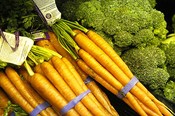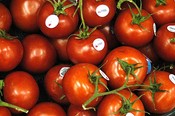 You’ve heard the promises, “Eat this” and “do that” and your health will improve dramatically in a week! That phrase is so ubiquitous in today’s search for the “magic bullet”. Recently, much attention has been given to the food we eat and our lifestyle. It seems as though not a week goes by without someone or some company claiming to have found the fountain of youth through a new miracle food, supplement, or exercise regime. However, there has always been a little known beneficial plant based compound in our diet, the ever faithful phytochemical. You will find out shortly that by eating a variety of fruits and vegetables you will undoubtedly taste a rainbow of flavor. Part of our diet was created long ago if you read from the Bible in the first chapter of Genesis. There you find that on the third day God created vegetation on the earth. God saw what the plants and trees put forth and called it good. In fact the vegetation is so good that even to this day it helps us to maintain a healthy body just as God designed.
You’ve heard the promises, “Eat this” and “do that” and your health will improve dramatically in a week! That phrase is so ubiquitous in today’s search for the “magic bullet”. Recently, much attention has been given to the food we eat and our lifestyle. It seems as though not a week goes by without someone or some company claiming to have found the fountain of youth through a new miracle food, supplement, or exercise regime. However, there has always been a little known beneficial plant based compound in our diet, the ever faithful phytochemical. You will find out shortly that by eating a variety of fruits and vegetables you will undoubtedly taste a rainbow of flavor. Part of our diet was created long ago if you read from the Bible in the first chapter of Genesis. There you find that on the third day God created vegetation on the earth. God saw what the plants and trees put forth and called it good. In fact the vegetation is so good that even to this day it helps us to maintain a healthy body just as God designed.
You may be asking what are phytochemicals? Some you know by their common names such as flavonoids and carotenoids. Technically, phytochemicals are nonnutritive chemical compounds that are produced by various plants. They aren’t classified as nutrients like carbohydrates, fats, or proteins, but they do contain qualities that help prevent several health conditions such as cancer, diabetes, and heart disease. Phytochemicals are found in fruits, vegetables, whole grains, and legumes. Most likely, they’re in many of the foods you eat everyday. There are thousands of phytochemicals and only a fraction of them have been studied with any detail. Supplement stores sell phytochemicals in a pill form, but there is no scientific evidence to date that supplements are as beneficial as eating whole foods.
 Interested in incorporating more phytochemicals in your diet? Eat ROYGBIV. ROYGBIV? Do you remember that acronym describing the colors of the rainbow? Just think about eating food of the colors that make up a rainbow which are green, red, white, blue/purple, and orange/yellow to be exact. A great way to get these compounds in your diet is through colorful fruits and vegetables. The National Cancer Institute recommends that men try for nine servings of fruits and vegetables a day and that women aim for seven. WWW.5ADAY.ORG suggests eating at least “5 a day the color way.” Eating weekly from an array of colors is as simple as having an orange, banana, or blueberries for breakfast. Try adding colorful fruits and vegetables when making a salad. When at work keep dried fruits in your desk for a quick and easy mid-morning or mid-afternoon snack.
Interested in incorporating more phytochemicals in your diet? Eat ROYGBIV. ROYGBIV? Do you remember that acronym describing the colors of the rainbow? Just think about eating food of the colors that make up a rainbow which are green, red, white, blue/purple, and orange/yellow to be exact. A great way to get these compounds in your diet is through colorful fruits and vegetables. The National Cancer Institute recommends that men try for nine servings of fruits and vegetables a day and that women aim for seven. WWW.5ADAY.ORG suggests eating at least “5 a day the color way.” Eating weekly from an array of colors is as simple as having an orange, banana, or blueberries for breakfast. Try adding colorful fruits and vegetables when making a salad. When at work keep dried fruits in your desk for a quick and easy mid-morning or mid-afternoon snack.
Here are how some people are able to implement this into their daily lives:
Mason Hewlitt, realtor, age 31
“Sometimes I’m driving across town all day so I try and plan ahead to make sure I have some type of snack with me. Eating these snacks also help stave off my hunger so I don’t overeat at lunch or dinner.”
Sarah Williams, stay at home mom, age 35
“Taking care of kids can be very time consuming and strenuous at times. However, I try to incorporate snack time with the kids in which we are able to enjoy healthy snacks.”
 It has been my experience in working with various clients that planning ahead is the key in preparing meals, especially snacks. After you get home from the grocery store instead of storing the fruits and vegetables, cut them up and put them in baggies or Tupperware so that they are ready to go with you when you walk out the door. You are more likely to eat them if they are already prepared. Though very tasty, phytochemicals can be very complex compounds. Scientists are just beginning to understand the roles that they play in human nutrition. When researchers discover new phytochemicals and how they benefit the body it just proves how infinite God’s wisdom is when he created the earth.
It has been my experience in working with various clients that planning ahead is the key in preparing meals, especially snacks. After you get home from the grocery store instead of storing the fruits and vegetables, cut them up and put them in baggies or Tupperware so that they are ready to go with you when you walk out the door. You are more likely to eat them if they are already prepared. Though very tasty, phytochemicals can be very complex compounds. Scientists are just beginning to understand the roles that they play in human nutrition. When researchers discover new phytochemicals and how they benefit the body it just proves how infinite God’s wisdom is when he created the earth.
Even though you can’t change your health over night, consistently eating a balanced diet comprised of several colors may do just that. Although there is still a great deal to learn about phytochemicals, the research thus far shows promising results for what the plant based compounds can do for the body. As the adage goes, the proof is in the pudding, or should I say, rainbow!
|
On-line Community Network
|
Go to our forums and share what you’ve learned or found interesting from this article. Apply the ideas into your overall personal wellness and fitness plan and then let us know if your workouts become more energized.
|









